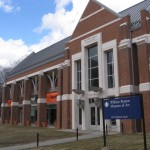A couple weeks ago, I signed up for a guided tour of UConn’s Benton Museum sponsored by The Last Green Valley, an organization active in promoting natural and cultural amenities in the Quinebaug-Shetucket Rivers watershed. I knew that the drive to UConn is about the same distance as my commute to UMass; the tour was scheduled to start at 1:30, so I was on the road shortly after noon. When I arrived, the campus seemed deserted, and I figured that UConn students had started their Spring Break at the same time as our students.
The William Benton Museum of Art is actually an “official State of Connecticut art museum” (who even knew there was such a thing) and has a rather interesting history. The building now housing some 6000 art objects was originally the college dining hall; it was known as the Beanery. It was converted into a museum in 1967, with a new gallery added in 2005 at the same time as other major renovations were completed. Mr Benton, for whom the museum is named, was a senator from Connecticut and also a UConn trustee.
Over the years, the museum’s permanent collection has grown significantly from the original works of mostly American art donated by UConn president Charles Lewis Beach. The museum also features changing exhibitions, lectures, recitals, and readings. Admission is free to both students and the general public, but of course, donations are most welcome.
We were a big group of over 20 people, so we split into two smaller groups.
Nancy, one of the two personable and knowledgeable docents on duty today, took us through the galleries in which the changing exhibits were displayed.
Making the Movement Move: Photography, Student Activism, and Civil Rights is a photography exhibit featuring the work of two very different photographers, Ernest Withers and Danny Lyon. The Civil Rights Movement began in this country more than fifty years ago, which means the photographs date from the fifties and early sixties. Ernest Withers, born in 1922, was an African-American who grew up in Memphis, trained in the US Army as a photographer, and later came to know all of the leaders of the Civil Rights Movement through his photography work (eventually it became clear that he was also a paid FBI informant). Danny Lyon was a 20-year-old history student at the University of Chicago when he was given the opportunity to jump into the thick of the protests; he worked for two years in the Civil Rights Movement and went on after that to photograph other subjects. Both photographers’ images are aesthetically striking and eloquent reminders that these momentous events which precipitated a sea-change in race relations took place in my lifetime.
Persepolis grew out of the “UConn Reads” program. The campus chose to read this graphic novel written by Marjane Satrapi, who was born in 1970 and grew up in Iran; she was a rebellious teenager when revolution broke out in 1979. I know my readers don’t remember, but the animated movie Persepolis, written and directed by Ms Satrapi, appears on my “Best of 2008” list which I posted to this blog in January 2009; click on the link to see for yourself! This exhibit considers the question of text versus images and depicts how words and pictures have been combined in historical and contemporary works. Owing to the importance of calligraphy in Islamic culture, the focus on Iranian artists is certainly fitting. Works by Shirin Neshat (a name which even I recognize), Afarin Rahmanifar from ECSU, cartoonist Ardeshir Mohassess, Pouran Jinchi, and Hadieh Shafie are displayed, but so also is the work of American artists such as William Gropper, a twentieth-century cartoonist and muralist who is best known for his radical politics.
Mary Kate, the other docent, then led our group on a tour of the Evelyn Simon Gilman Gallery, which houses the Museum’s permanent collection; this current selection of works is titled From Old Masters to Revolutionaries: Five Centuries of the Benton’s Best.
As one might expect, American and English artists are well represented, but there are also works by artists from Continental European countries such as the Netherlands, Italy, Germany, and France. The works include a range of subject matters, from portraits to landscapes to still lifes, executed in a variety of media, from oils and watercolors to woodcuts and lithographs to sculpture. I was pleased that I recognized the major stylistic trends: portraiture, Impressionism, Expressionism, abstraction, primitivism, Ashcan School (“life as it is lived”). I couldn’t even pick a few favorites, though I have to say that I was in the mood by then for lovely and elegant, so was glad to admire the Reginald Marsh paintings, of which the Museum has a good selection.
